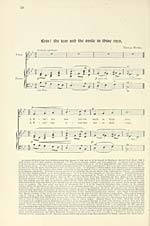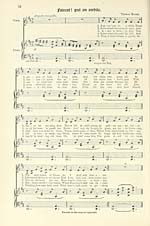Glen Collection of printed music > Printed music > Minstrelsy of Ireland
(69) Page 51
Download files
Complete book:
Individual page:
Thumbnail gallery: Grid view | List view

|"Ie
--,--
ERIN 1 THE TEAR AND THE SMILE IN THINE EYES.
n
z<*zz£z
=t
mf
=^c
=p=
51
m
^— it
4*=t
±
1. Blend like the rain - bow that hangs in thy
2. E - rin ! thy Ian - guid smile ne'er shall in
skies !
crease !
Shin - ing thro'
Till, like the
semprei con Fed.
i
9
^t
~-W-
*=
*
^^
???/ n'i. e espress.
5J 1- ' 1
*}
1. sor - row's stream, Sad - d'ning thro'
2. rain - how's light Thy var - ious
plea - sure's beam, Thy suns, with
tints u - nite, And form in
2±
±=$-
5^E
m=^
mf rit. e espi'ess.
-W
^
*C
I
-£
^i
^=
■>
^
§
±
1. doubt
2. Hea
ful gleam, Weep while they
ven's sieht One arch of
version of the air held ground and became an especial favourite in Scotland until the close of the century. It is to he found in
Oswald's Pocket Companion, Bk. v., c. 1750 ; Johnson's Guittar Tutor, e. 1755 ; Bremner's Guittar Tutor, c. 1758-9 ; McLean's Collection,
1772 ; Clarke's Flares Musieae, 1773 ; Shield's Mountains of Wicklow, 1798, and many other works. This, then, takes us up to the
present version, as used by Tom Moore and now sung all over the civilized world. That it was known in Scotland, and that it
was there associated with a number of old songs is evident ; " You're Welcome to Paxton Town, Eobin Adair," with the air
exactly as adopted by Moore, is printed in the Edinburgh Musical Miscellany, vol. it, 1793 ; it is alluded to by Bums in Crornek's
Jteliques, 1808, in a footnote to the "Address to General Dumourier, a parody on 'Robin Adair.'" The real ballad of " Robin Adair,"
beginning " What's this dull town to me," does not appear to have been written until later ; the version of the air containing the
so-called " Scotch snap " was apparently introduced by Braham the singer, and in Bryson's Complete Repository, Edinburgh, c. 1820,
(not earlier than 1819, nor later than 1821) we find it entitled ".Robin Adair. New Sett sung by Mr. Braham" ; in the London
Minstrel, 1823, the ballad and the air are published. I will not enter into the well-known traditional story of Adair and Lady
Catharine Keppel, because, although possibly the foundation of the modern ballad, it has no direct bearing upon the version of
the air in question. In 1803, George Thomson republished the setting from the Edinburgh Miscellany, with piano accompaniment
by Joseph Haydn, and it was probably from this then fashionable work that Moore obtained the air to which he wrote his
immortal song " Erin, the tear and the smile in thine eye," for the first number of the Melodies, 1807. By whom this so-called
" Robin Adair" version was composed it is impossible to say ; but no one will venture to deny its infinite superiority over the old
florid setting used by Mistress Clive. From time to time we hear of traditional settings of ■' Aileen a Roon " beingdiseovered in
"secluded spots" ; these are generally obtained from the singing of "old women," and are announced as "pure," "ancient,"
" original," and so on. But when we come to consider how almost impossible it is for an air to be handed about from mouth to
mouth, and from generation to generation, without undergoing immense changes, the importance of these " traditional "
settings diminishes. Considering that the present air, with Tom Moore's song, has been popular in every field and cabin in
Ireland for almost a century, it stands to reason that all existing versions of the melody must have been more or less
influenced by it.
--,--
ERIN 1 THE TEAR AND THE SMILE IN THINE EYES.
n
z<*zz£z
=t
mf
=^c
=p=
51
m
^— it
4*=t
±
1. Blend like the rain - bow that hangs in thy
2. E - rin ! thy Ian - guid smile ne'er shall in
skies !
crease !
Shin - ing thro'
Till, like the
semprei con Fed.
i
9
^t
~-W-
*=
*
^^
???/ n'i. e espress.
5J 1- ' 1
*}
1. sor - row's stream, Sad - d'ning thro'
2. rain - how's light Thy var - ious
plea - sure's beam, Thy suns, with
tints u - nite, And form in
2±
±=$-
5^E
m=^
mf rit. e espi'ess.
-W
^
*C
I
-£
^i
^=
■>
^
§
±
1. doubt
2. Hea
ful gleam, Weep while they
ven's sieht One arch of
version of the air held ground and became an especial favourite in Scotland until the close of the century. It is to he found in
Oswald's Pocket Companion, Bk. v., c. 1750 ; Johnson's Guittar Tutor, e. 1755 ; Bremner's Guittar Tutor, c. 1758-9 ; McLean's Collection,
1772 ; Clarke's Flares Musieae, 1773 ; Shield's Mountains of Wicklow, 1798, and many other works. This, then, takes us up to the
present version, as used by Tom Moore and now sung all over the civilized world. That it was known in Scotland, and that it
was there associated with a number of old songs is evident ; " You're Welcome to Paxton Town, Eobin Adair," with the air
exactly as adopted by Moore, is printed in the Edinburgh Musical Miscellany, vol. it, 1793 ; it is alluded to by Bums in Crornek's
Jteliques, 1808, in a footnote to the "Address to General Dumourier, a parody on 'Robin Adair.'" The real ballad of " Robin Adair,"
beginning " What's this dull town to me," does not appear to have been written until later ; the version of the air containing the
so-called " Scotch snap " was apparently introduced by Braham the singer, and in Bryson's Complete Repository, Edinburgh, c. 1820,
(not earlier than 1819, nor later than 1821) we find it entitled ".Robin Adair. New Sett sung by Mr. Braham" ; in the London
Minstrel, 1823, the ballad and the air are published. I will not enter into the well-known traditional story of Adair and Lady
Catharine Keppel, because, although possibly the foundation of the modern ballad, it has no direct bearing upon the version of
the air in question. In 1803, George Thomson republished the setting from the Edinburgh Miscellany, with piano accompaniment
by Joseph Haydn, and it was probably from this then fashionable work that Moore obtained the air to which he wrote his
immortal song " Erin, the tear and the smile in thine eye," for the first number of the Melodies, 1807. By whom this so-called
" Robin Adair" version was composed it is impossible to say ; but no one will venture to deny its infinite superiority over the old
florid setting used by Mistress Clive. From time to time we hear of traditional settings of ■' Aileen a Roon " beingdiseovered in
"secluded spots" ; these are generally obtained from the singing of "old women," and are announced as "pure," "ancient,"
" original," and so on. But when we come to consider how almost impossible it is for an air to be handed about from mouth to
mouth, and from generation to generation, without undergoing immense changes, the importance of these " traditional "
settings diminishes. Considering that the present air, with Tom Moore's song, has been popular in every field and cabin in
Ireland for almost a century, it stands to reason that all existing versions of the melody must have been more or less
influenced by it.
Set display mode to: Large image | Transcription
Images and transcriptions on this page, including medium image downloads, may be used under the Creative Commons Attribution 4.0 International Licence unless otherwise stated. ![]()
| Special collections of printed music > Glen Collection of printed music > Printed music > Minstrelsy of Ireland > (69) Page 51 |
|---|
| Permanent URL | https://digital.nls.uk/91382791 |
|---|
| Description | Scottish songs and music of the 18th and early 19th centuries, including music for the Highland bagpipe. These are selected items from the collection of John Glen (1833 to 1904). Also includes a few manuscripts, some treatises, and other books on the subject. |
|---|
| Description | The Glen Collection and the Inglis Collection represent mainly 18th and 19th century Scottish music, including Scottish songs. The collections of Berlioz and Verdi collected by bibliographer Cecil Hopkinson contain contemporary and later editions of the works of the two composers Berlioz and Verdi. |
|---|

